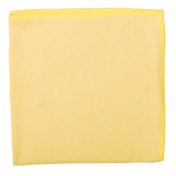In our third part of the flooring series, we look at linoleum. Here, too, we look at the properties, the material, the advantages and disadvantages and, of course, how to clean and maintain linoleum.
The History of Linoleum
Linoleum was discovered more than 100 years ago by the Englishman Frederick Walton. He used linseed oil, among other things, to make linoleum. The name linoleum is derived from the Latin, as "linum" means glue and "oleum" means oil . In addition to linseed oil, cork flour and jute fabric are used in the production process. Linoleum has been manufactured according to the original recipe since 1898.
What is linoleum actually made of?
As already mentioned, linseed oil, cork flour and jute fabric are components of linoleum. Linoleum is therefore mainly made of raw materials, almost all of which are renewable . Linseed oil and pine resin combine with the jute carrier to form the floor covering. The different components all come from nature and have an antibacterial and hygienic effect . Other ingredients for the natural linoleum floor are, for example, flax, wood flour, cork dust and calcium carbonate.
Where can linoleum be used?
The natural floor covering linoleum is not only a natural product, but also very versatile and can be used in many different areas . Linoleum can be used in both commercial and private spaces and there is a suitable covering for every need. Not only can the thickness, pattern and color be selected, but certain properties such as anti-slip, conductive or impact sound insulation are also possible .
Advantages and Disadvantages of Linoleum
The biggest advantage is that linoleum is a recyclable floor covering that is made of 97% natural ingredients. It is also very versatile and can be easily adapted to trends . The covering also has some naturally positive properties. It is durable, non-slip, conductive, dissipative and resistant to oils, fats and chemicals . Impact sound insulation can also be an advantage for some rooms or buildings. Linoleum is also ideal as a hygienic floor because it inhibits the growth of bacteria on the floor.
The disadvantage of linoleum flooring is that it is just as sensitive to water as wood. This means it is not ideal for rooms with a lot of moisture. Another negative point is that the material reacts with alkaline agents, so in addition to cleaning, special care must be taken to ensure that nothing of the sort gets onto the floor. Two other small negative points are that it has an odor for some time after laying and that the color changes under UV rays .
How to properly care for and clean linoleum
As already mentioned, linoleum is made of natural materials such as linseed oil, jute fabric or cork powder. Therefore, no alkaline cleaning agents may be used when cleaning. This means that cleaners with a pH value of 9 or higher can destroy the floor. Acidic and neutral cleaners are suitable. The floor should be wiped with a slightly damp cloth ; a highly absorbent mop can be helpful for this. It is also important when wiping not to leave puddles and, if possible, not to use rough sponges or cloths . These can scratch the floor.
The floor should be cleaned regularly of dust and dirt. A vacuum cleaner or a broom is suitable for this. If additional care is required after the basic cleaning, the linoleum can be polished. A mixture of vinegar and vegetable oil (ratio 1:1) and a soft cotton cloth can help to restore the shine and elasticity.
Mundizio therefore recommends: Dr. Schnell Floortop High Performance Wiping Care
The high-performance Floortop cleaning product from Dr. Schnell is ideal for cleaning linoleum. Here, too, the floor is cared for, cleaned and revitalized in one step. The cleaner has a high wetting capacity and a high dirt-dissolving power. This means that dirt can be removed in no time at all. A streak-free cleaning result is guaranteed.
All blog posts about the flooring series at a glance
- cork
- Carpet
- PVC
- Linoleum
- parquet
- laminate
- natural stone
- tiles



